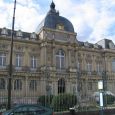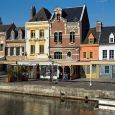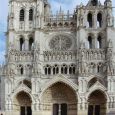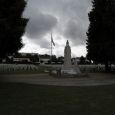Amiens
Advertisement
By Air
In addition to Glisy aerodrome bordering on the town's eastern edge, there are several airports nearby
Beauvais-Tillé Airport (served by a bus service from Amiens)
Lille Airport (reachable by train or by road using the A29 and A1)
Paris-Charles de Gaulle Airport (reachable by train or by road using the A29 and A1, or A16 and N104)
By train
Amiens has two stations: the Gare d'Amiens (the former Gare du Nord) and the Gare de Saint-Roch (Somme), with connections:
to Lille via Arras and Douai
to Boulogne via Abbeville
to Paris-Nord via Creil or Compiègne
to Reims via Tergnier
to Rouen
By water
The Somme canal runs through the town to the English Channel. This canal is linked to the Canal du Nord (Paris to Lille metropolitan area)
By road
Amiens is served by several motorways
A16 to Calais via Abbeville and Boulogne-sur-Mer
A16 to Paris via Beauvais
A29 to Rouen and Le Havre via Neufchatel-en-Bray
A29 to Reims via Saint-Quentin and Laon
The proposed A24 autoroute from Amiens to Lille via Doullens was cancelled in 2006.
Amiens Cathedral
The Cathedral of Our Lady of Amiens, or simply Amiens Cathedral, is a Roman Catholic cathedral and seat of the Bishop of Amiens . It is situated on a slight ridge overlooking the River Somme in the administrative capital of the Picardy region of France, some 120 km north of Paris.The cathedral is the tallest complete cathedral in France, its stone-vaulted nave reaching a height of 42.30 metres. It also has the greatest interior volume of any French cathedral, estimated at 200,000 cubic metres . The cathedral was built between 1220 and c.1270 and has been listed as a UNESCO World Heritage Site since 1981. Although it has lost most of its original stained glass, Amiens Cathedral is renowned for the quality and quantity of early 13th century Gothic sculpture in the main west facade and the south transept portal, and a large quantity of polychrome sculpture from later periods inside the building.
Saint-Acheul
This is where archeologic excavations have enabled to discover prehistoric rests, which have given the name of the area to a prehistorical era "Acheulean". In St-Acheul also lies a famous 1914–1918 military cimetary. It comprises the so called "English neighbourhood" with typical English style houses. At the feet of this area lies the hortillonnages.
Henriville
The Henriville neighbourhood was mostly built during the 19th century after the demolition of the city wall. It lies at the south of the town-centre and gathers numerous bourgeois houses and a certain number of town houses such as Jules Verne's house. Several examples of the architectural styles of the times like néoclassique, troubadour and néogothique, can be found there.
Musee de Picardie
The Musee de Picardie is the main museum of Amiens and Picardy, at 48, rue de la République. Its collections stretch from prehistory to the 19th century and form one of the largest regional museums in France.Its building was purpose-built for a regional museum between 1855 and 1867. The architects were Henri Parent and Arthur-Stanislas Diet. It was built thanks to militant action by the Societe des Antiquaires de Picardie, keen to give the city somewhere to house the collections the society had gathered over decades.
Saint-Maurice
Situated in between the east of the citadel and the Madeleine cemetery, St-Maurice is one of the industrial parts of Amiens. It is a working-class area which is currently being renovated and rearranged. The walls of the town's former factory of dye are now those of the Ecole Supérieure d'Art et de Design (ESAD) as well as those of the Faculty of Arts. The Ecole superieure d'ingénieurs en électronique et electrotechnique (ESIEE) is in the same neighbourhood.
Saint-Leu
St-Leu remains the most famous area. It lies at the north of the town-centre at the feet of the cathedral. Numerous canals run through its typical wooden and brick houses. It used to be a poor part of town which has been renovated during the 1990s. Nowadays, it is one of the most touristic areas of Amiens gathering various cafés restaurants and discothèques. It is also the place for local culture, with Chés Cabotans theatre (puppet shows in Picard language) and La Lune des Pirate, a famous concert room. It has also become home for students bringing night life to the town.
Information not available





